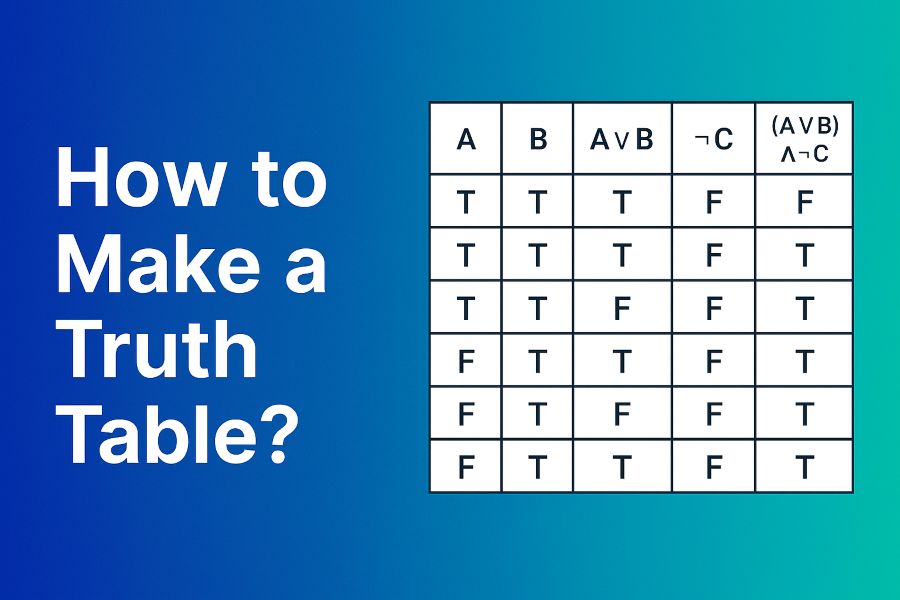Introduction
Truth tables are fundamental tools in logic, computer science, and mathematics used to analyze and visualize logical expressions. Whether you are a student learning Boolean algebra, a programmer designing circuits, or simply curious about logic, knowing how to make a truth table is essential. This guide will walk you through the process of creating truth tables step-by-step, explain their components, and provide examples to help you master the skill.
What Is a Truth Table?
A truth table is a tabular representation that shows all possible combinations of truth values for given logical variables and the resulting output of logical expressions. It helps to verify logical equivalences, simplify expressions, and analyze digital circuits.
Why Learn How to Make a Truth Table?
- Logical clarity: Truth tables provide a clear visualization of how different input combinations affect output.
- Problem-solving: They help simplify complex logical expressions.
- Circuit design: Used extensively in designing and testing digital circuits and computer algorithms.
- Exam preparation: Often required in math, philosophy, and computer science courses.
Understanding the Basics: Logical Operators
Before making a truth table, you should understand the basic logical operators commonly used:
- AND ( ∧ ): True only if both operands are true.
- OR ( ∨ ): True if at least one operand is true.
- NOT ( ¬ ): Inverts the truth value.
- IMPLICATION ( → ): False only if the first operand is true and the second is false.
- BICONDITIONAL ( ↔ ): True when both operands are the same.
Step-by-Step Guide: How to Make a Truth Table
Step 1: Identify Variables
Determine all unique variables involved in the logical expression. For example, in the expression (A∧B)∨¬C(A \land B) \lor \neg C(A∧B)∨¬C, the variables are A, B, and C.
Step 2: Calculate Number of Rows
The number of rows in a truth table is 2n2^n2n, where nnn is the number of variables. For 3 variables, you need 23=82^3 = 823=8 rows to cover every combination.
Step 3: List Variable Combinations
Create columns for each variable and list all possible combinations of truth values (True or False) in binary counting order:
| A | B | C |
|---|---|---|
| T | T | T |
| T | T | F |
| T | F | T |
| T | F | F |
| F | T | T |
| F | T | F |
| F | F | T |
| F | F | F |
Step 4: Add Columns for Sub-Expressions
Break down the original logical expression into smaller parts (sub-expressions) and add a column for each. Calculate their truth values based on the variable rows.
For example, for (A∧B)∨¬C(A \land B) \lor \neg C(A∧B)∨¬C, add columns for:
- A∧BA \land BA∧B
- ¬C\neg C¬C
- The entire expression (A∧B)∨¬C(A \land B) \lor \neg C(A∧B)∨¬C
Step 5: Calculate Truth Values for Sub-Expressions
Use the definitions of logical operators to fill in the truth values for each sub-expression row by row.
Step 6: Determine Final Expression Values
Based on the sub-expressions, compute the truth value of the complete expression for each row.
Example: How to Make a Truth Table for (A∧B)∨¬C(A \land B) \lor \neg C(A∧B)∨¬C
| A | B | C | A∧BA \land BA∧B | ¬C\neg C¬C | (A∧B)∨¬C(A \land B) \lor \neg C(A∧B)∨¬C |
|---|---|---|---|---|---|
| T | T | T | T | F | T |
| T | T | F | T | T | T |
| T | F | T | F | F | F |
| T | F | F | F | T | T |
| F | T | T | F | F | F |
| F | T | F | F | T | T |
| F | F | T | F | F | F |
| F | F | F | F | T | T |
Tips for Making Truth Tables Efficiently
- Start simple: Begin with basic expressions before progressing to complex ones.
- Use software tools: Truth table generators (like on TruthTableGenerator.io) automate this process.
- Double-check logic: Carefully verify each sub-expression’s truth values.
- Practice: The more tables you create, the easier it becomes.
Common Mistakes to Avoid
- Forgetting to include all variable combinations.
- Mixing up operator precedence (remember NOT > AND > OR).
- Skipping sub-expression calculations.
- Not clearly labeling columns.
Using Online Tools to Make Truth Tables
If manual truth tables seem time-consuming, you can use free online generators. For example, TruthTableGenerator.io offers a secure and anonymous platform where you can input logical expressions and get instant truth tables without logging in.
Applications of Truth Tables
- Digital electronics: Designing logic gates and circuits.
- Mathematical proofs: Verifying logical equivalences.
- Computer programming: Debugging conditional statements.
- Philosophy: Analyzing argument validity.
Conclusion
Learning how to make a truth table is an essential skill that simplifies understanding and analyzing logical expressions. With practice, you will gain confidence in constructing accurate tables, whether by hand or using online tools. Try building truth tables for various expressions today to sharpen your logical thinking!
Frequently Asked Questions (FAQs)
What is the simplest truth table I can create?
Start with one variable and two rows showing True and False.
Can truth tables have more than three variables?
Yes! But the number of rows doubles with each added variable, so tables can get large quickly.
Are truth tables only useful in computer science?
No, they are also widely used in math, philosophy, and digital electronics.

